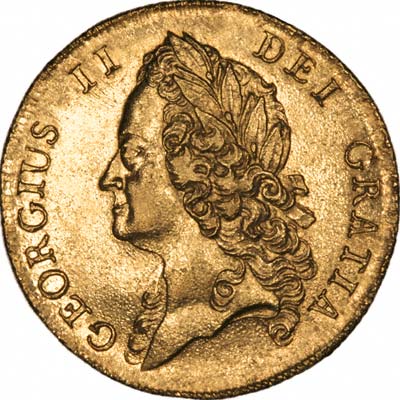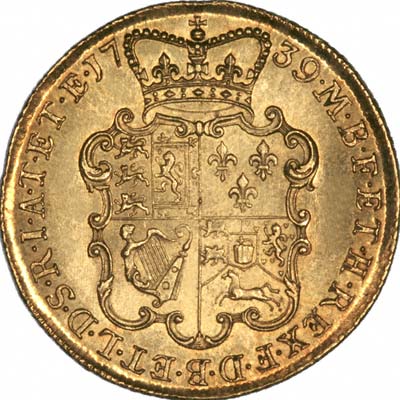| The Very Highest Quality Gold Two Guineas... |
| The Story of the English Two Guinea Piece |
|

|
|
|
 > >
|
|
|
Hammered to Milled
Although a regular English gold coinage had been in use since the time of Edward
III, the hand made hammering process of minting coins meant that the quality of
production, weight and purity could vary drastically. Although the magnificent
looking sovereign had been introduced during the reign of Henry VII and various
gold coinages were produced for each monarch after this, the method of
hammering coupled with the softness of gold as a metal meant that not only was
it relatively simple to clip the coins at a time when the intrinsic metal
content reflected the denominational value, but achieving a high relief on the
coins that wouldn't wear over time was also a problem, as was minting coins
with an edge to help prevent any illicit activity!
Cromwell Gets Broad
Despite the fact that superior coins of fine machine made workmanship were produced under Elizabeth I
in a screw press, these were only silver coins, the process was very slow, the machinery being produced by a
horse drawn mill (hence the adoption later on of the term 'milled coinage'),
and this meant even though their quality was far superior, it took another century
before the ancient process of hammering coins by hand was finally overtaken by
the machinery of the former French engineer Pierre Blondeau. Our accompanying
picture of a Cromwell broad shows the magnificent advancement in quality that
the age of milled coinage brought about. However, most evidence implies they
were only ever intended to be a
limited 'pattern' coinage. Because they were never mass
produced, all Cromwell coins are rare and highly sought after as their limited circulation probably aided
their lasting quality. When one considers the quality of some of the 'coins' minted
during the Civil War then the introduction of machine made coins can be viewed
as nothing less than a saving grace, though one could argue that production in
many areas of industry was always going to lean this way
The Two Guinea piece
Although the story of the two guinea piece shadows that of the five guinea, guinea and half guinea which can also be found on this website, each coin has its own distinctive story in terms of issues and designs with certain unique and highly sort after dates. On this basis alone the history of this denomination deserves its own page, and as we progress through its history, other unique stories and points will emerge which will more than justify the inclusion of what was and still is a quite magnificent gold coin as well as providing detailed information for those wishing to purchase ay of the two guineas we have in stock.
We've Struck Gold; but how Much is it Worth?
As with the rest of its denominational family, the two guinea gold coin would later get its name from the area in West Africa where most of the gold it would be minted from was mined. The coins heralded the dawn of the new milled coin age as machine made coin striking finally superseded the ancient hand hammering process. A new gold currency was devised to mark this fact, and in 1664 the two guinea would at first be known as a forty-shilling piece. Like the guinea and the five guinea it's value would vary wildly between its inception during the restoration of the monarchy under Charles II. and in 1717 when a Proclamation finally settled and fixed the price of a guinea at 21 shillings. From this point onwards the two guinea piece naturally became a coin worth 42 shillings.
John Roettier, A French Genius?
The rather magnificent obverse and reverse design was the work of John Roettier. Roettier is a very important figure in the story of the English coinage for it was he who brought back the Britannia figure into die engravings after a gap of almost 13 centuries. For a milled coinage moving into the future, Roettier and members of his family were thinking ahead of their time when it came to engraving, something that can be seen in the beauty of some of the early milled coinage.
Stop the Clipping
To avoid the clipping or filing of gold coins that had always happened with the hammered issues, the five guinea had an edge inscription engraved upon it. Although the two guinea was considered too thin for engraving, Roettier came up with the idea of milled edges. As well as distinguishing the coin from a gilded half-crown that had edge lettering, it meant that any filing of the coin would be obvious to all afterwards. Until 1669 the milling was in the form of vertical grooves, however after 1671 the milling was diagonal to the coin.
Only Lawrence Chard Works More Hours than John Roettier
First issued in 1664, the obverse of the two guinea piece showed a fine right facing portrait of Charles II wearing a laurel wreath. Roettier's reverse depicted four crowned cruciform shields bearing the arms of England, Scotland, France and Ireland. Between the shields were four sceptres and in the centre, as with a lot of Charles II coins, were four interlocked "C's"..
John Roettier carried on designing the dies for the two guineas coin during the short reign of James II. The coin had proved quite a success in it's infancy, at one point being minted every year from 1675-84 inclusive; something which would be common for a coin now, but back in the 17th century very few coins were issued every year without exception. Issued in 1687-88, the reverse was exactly the same apart from the omission of the interlocking "C's". What had changed was the value of the denomination itself. By the early part of James II's reign the guinea had increased to almost 30shillings, making the two guineas almost 60 shillings compared to it's original value of just 40.
Changing Monarchs and Different Designs
After this reign, and not completely unlike the five guinea piece, the two-guinea was not issued very frequently at all. Still the work of the Roettier family (probably James and/or Norbert), and despite the obvious difference in the conjoined head of William and Mary on the Obverse, the reverse design was completely changed as well. Now there was simply one large crowned central shield with the same arms inside. In the centre of this was another small shield bearing the rampant lion of Nassau. This design would later prove to be unsuccessful by the public and thus the sole issue under the reign of William III following Mary's death from smallpox in 1694 reverted to the 4 shield design of Charles II. This time the lion of Nassau was placed in a small shield in the centre.
This reversion back to the familiar design would continue for all issues of the two guinea under Queen Anne. Following the Union of Scotland and England in 1707, both countries arms began to appear conjoined upon one shield. Although only issued on four separate occasions, the coin was still very much a key denomination in the gold series. None of these issues are particularly rare, and each feature a Star of the Order of the Garter which replaced the Nassau lion on the reverse of the coin.
The Royal Proclomation of 1717 Fixes the Value
As previously mentioned at the beginning of this piece, it was only a few years into the reign of George I that the ever fluctuating guinea was finally fixed as 21 shillings by A Royal Proclamation of December 1717 at the urging of none other than Sir Isaac Newton, who was the Master of the Mint at that time. Instead of this being a sign to mint more regular issues, the exact opposite happened to the two guinea and its production became less and less frequent. For George I, who added the legend BRVN ET L DVX S R I A TH ET EL to his coinage, meaning Duke of Brunswick and Luenburg, Arch-Treasurer and Elector of the Holy Roman Empire, two guinea coins were struck in only 1717, 20 and 1726.
Priceless Patterns and No More, After 1754
This limited production was not even a lull before the storm as George II's two guinea pieces were the last of the denomination. Despite the fame of certain issues of guineas of George III, the only five guineas or two guineas issued during the reign are very rare and very expensive pattern coins that were never struck for general circulation. The few issues of the series that began in 1734 and ended in 1753 reverted back to the James II reverse of one large central crowned shield with the coats of arms inside. It is also worth noting that the milled edge of the two guineas was altered after 1739 following a quite high profile case involving a gang of guinea filers. This lead to a chevron or arrow-head shaped milling making it even harder to file gold from them.
How can we make a £2 Coin That People Like
After 1754, the two guinea piece was no more. The first milled attempt at a regular issue of what was in essence a two-pound coin had lasted under a century. It wouldn't be until the great re-coinage of 1816 that the minting of a £2 type coin would be attempted once again, though it was never intended for general circulation. In fact it wasn't until Queen Victoria's golden Jubilee of 1887 that a £2 or 40shilling gold coin would be issued as a proof as well as being struck for normal circulation. There must be something inherently hard to grasp or like about the £2 coin from the British public. Even towards tail end of the 20th century when we had completely moved away from any kind of intrinsic currency, or one based on a gold standard to a token currency, people still seemed to find it hard to take to a £2 coin. Various commemorative issues from 1986 onwards were never issued in big enough volumes to enter everyday currency, and it took the novelty of a bi-metallic £2 coin in 1997 for the modern day relation of the two guinea piece to finally be accepted as a standard denomination.
A Tale Worth Telling
Though we said at the beginning of this tale that the story of the two guinea shadowed that of the five guinea and guinea piece very closely, there are more than enough issues, dates and stories surrounding the coin. The early age of the milled coin had brought about fantastic steps in machine-based ways for making coins, and anti-clipping methods had lead to milled edges, a feature still present on the base metal token coinages that exist today.
Machine Made
Technical Specifications
| Diameter | 30mm |
| Weight | 16.70 Grams |
| Alloy | 22 carat |
| Fineness | 0.9166 |
| Actual gold content | 0.4922 ounces |
| ...at the Lowest Possible Price |
|
32 - 36 Harrowside, Blackpool, Lancashire, FY4 1RJ, England.
Telephone (44) - (0) 1253 - 343081 ; Fax 408058; E-mail: The URL for our main page is: https://24carat.co.uk |
Web Design by Snoop |